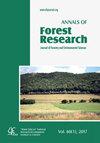东北6种观赏树种在“假春”胁迫下芽的生物量、碳水化合物和渗漏电导
IF 2.9
3区 农林科学
Q2 FORESTRY
引用次数: 2
摘要
关于晚春霜冻对观赏树木芽生理反应的可能影响的信息非常稀少。本研究以东北长春市为研究对象,通过对2017年4月上旬异常升温和骤冻的探测,识别假春的特征。2017年4月7日、14日、21日和28日,对6种地方观赏树种芽的生物量、非结构性碳水化合物和抗冻性动态进行了研究。根据2007年至2016年的历史春季气温记录对比,确定为假春季。黑松(Pinus tabuliformis var. mukdensis)的芽生物量大于杏(Prunus sibirica L.)。桃树(Prunus persica L. ar. persica f. rubor -plena Schneid.)在冷冻后芽中保留的非结构碳水化合物含量高于黑松,杏和柳树(Salix babylonica L.)的芽中可溶性糖和淀粉含量分别高于黑松。温度低于12℃的累积日数与sorbus pohuashanensis [Hance] Hedl.)的相对电导率呈负相关。4月21日,甜樱桃(Padus virginia ' Canada Red ')的芽淀粉含量最高。总体而言,晚春霜冻在4月下旬之前对观赏树木的碳水化合物代谢造成中断,而不是直接损害。提前变暖对假春的负面影响比最低气温的突然下降更为显著。本文章由计算机程序翻译,如有差异,请以英文原文为准。
Biomass, carbohydrate, and leakage conductance in buds of six ornamental tree species subjected to a “false spring” in Northeast China
Information is highly scarce about the possible effect of a late spring frost on physiological response of buds in ornamental trees. In this study, spring temperature of Changchun at Northeast China was recorded to identify the characteristics of a false spring by detecting extraordinary warming and sudden freeze in early April of 2017. Buds of six local ornamental tree species were investigated for their dynamics in biomass, non-structural carbohydrates, frost resistance on days of 7, 14, 21, and 28 April 2017. According to a comparison with spring temperature records historically from 2007 to 2016, a false spring was determined. Black pine (Pinus tabuliformis var. mukdensis) had greater bud biomass than apricot (Prunus sibirica L.). Peach (Prunus persica L. var. persica f. rubro-plena Schneid.) reserved greater non-structural carbohydrate content in post-chilling buds than black pine, and apricot and willow (Salix babylonica L.) had greater soluble sugars and starch contents in buds, respectively. Cumulative number of days with temperature below 12°C had a negative relationship with relative conductance in sorbus (Sorbus pohuashanensis [Hance] Hedl.). Chokecherry (Padus virginiana ‘Canada Red’) had greatest bud starch content on 21 April. Overall, a late spring frost imposed interruption on carbohydrate metabolism rather than direct damage on buds of ornamental trees before late April. Advanced warming induced more pronounced negative impact of a false spring than the sudden decline of minimum temperature.
求助全文
通过发布文献求助,成功后即可免费获取论文全文。
去求助
来源期刊

Annals of Forest Research
FORESTRY-
CiteScore
2.20
自引率
11.10%
发文量
11
审稿时长
12 weeks
期刊介绍:
Annals of Forest Research is a semestrial open access journal, which publishes research articles, research notes and critical review papers, exclusively in English, on topics dealing with forestry and environmental sciences. The journal promotes high scientific level articles, by following international editorial conventions and by applying a peer-review selection process.
 求助内容:
求助内容: 应助结果提醒方式:
应助结果提醒方式:


